

Week One Creative Writing Lesson Plans: Expert Guide
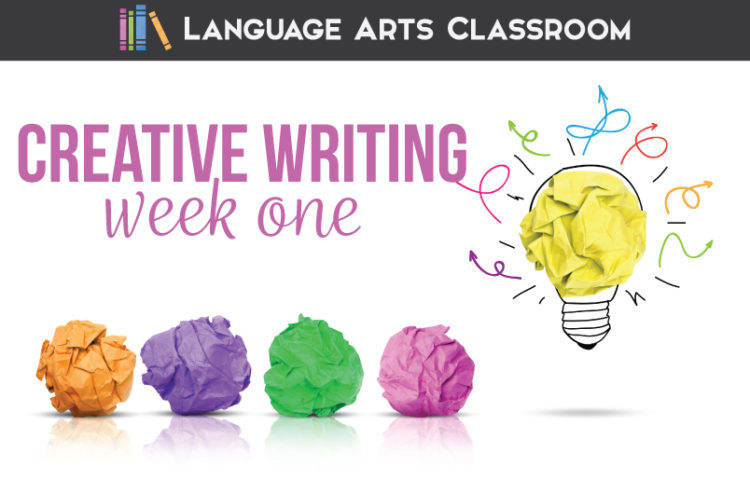
Looking for creative writing lesson plans? I am developing creative writing lesson ideas!
I’ve written and revamped my creative writing lesson plans and learned that the first week is vital in establishing a community of writers, in outlining expectations, and in working with a new class.
What are some good creative writing exercises?
Some good creative writing exercises include writing prompts, free writing, character development exercises, and fun writing games.
The first week, though, we establish trust—and then we begin powerful creative writing exercises to engage young writers and our community.
How can add encouragement in creative writing lesson plans?
I’ve found students are shy about writing creatively, about sharing pieces of themselves. A large part of the first week of class is setting the atmosphere, of showing everyone they are free to create. And! These concepts will apply to most writing lesson plans for secondary students.
Feel free to give me feedback and borrow all that you need! Below, find my detailed my day-by-day progression for creative writing lesson plans for week one.

Creative Writing Lesson Day One: Sharing my vision
Comfort matters for young writers. I’m not a huge “ice breaker” type of teacher—I build relationships slowly. Still, to get student writing, we must establish that everyone is safe to explore, to write, to error.
Here are some ideas.
Tone and attitude
For day one with any lesson plan for creative writing, I think it is important to set the tone, to immediately establish what I want from my creative writing students. And that is…
them not to write for me, but for them. I don’t want them writing what they think I want them to write.
Does that make sense? Limitations hurt young writers. My overall tone and attitude toward young writers is that we will work together, create and write together, provide feedback, and invest in ourselves. Older kiddos think that they must provide teachers with the “correct” writing. In such a course, restrictions and boundaries largely go out the window.
Plus, I specifically outline what I believe they can produce in a presentation to set people at ease.
The presentation covers expectations for the class. As the teacher, I am a sort of writing coach with ideas that will not work for everyone. Writers should explore different methods and realize what works for them. First, not everyone will appreciate every type of writing—which is fine. But as a writing community, we must accept that we may not be the target audience for every piece of work.
Therefore, respect is a large component of the class. Be sure to outline what interactions you find acceptable within your classroom community.
Next, as their writing coach, I plan to provide ideas and tools for use. Their job is to decide what tools work for their creative endeavors. My overall message is uplifting and encouraging.
Finally, when we finish, I share the presentation with students so they can consult it throughout the semester. The presentation works nicely for meet-the-teacher night, too!
After covering classroom procedures and rules, I show students a TED Talk. We watch The Danger of a Single Story by Chimamanda Adichie. My goal is to show students that I don’t have a predetermined idea concerning what they should write. This discussion takes the rest of the class period.
Establishing comfort and excitement precedents my other creative writing activities. Personalize your “vision” activities for your lessons in creative writing. Honestly, doing this pre-work builds relationships with students and creates a positive classroom atmosphere.
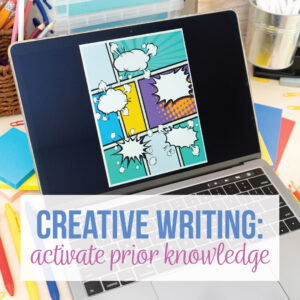
Creative Writing Lesson Day Two: Activating prior knowledge
Students possess prior knowledge concerning creative writing, but they might not consider that. Students should realize that they know what constitutes a great story. They might not realize that yet. An easy lesson plan for creative writing that will pay off later is to activate prior knowledge. Brainstorm creative, memorable, unforgettable stories with students. Share your thoughts too! You will start to build relationships with students who share the same tastes as you (and those that are completely different!).
Activation activity
During this activity, I want to see how students work together, and I want to build a rapport with students. Additionally, activating prior knowledge provides a smooth transition into other creative writing activities.
This creative writing activity is simple:
I ask students to tell me memorable stories—books, play, tv shows, movies—and I write them on the board. I add and veto as appropriate. Normally doing these classroom discussions, we dive deeper into comedies and creative nonfiction. Sometimes as we work, I ask students to research certain stories and definitions. I normally take a picture of our work so that I can build creative writing lessons from students’ interests.
This takes longer than you might think, but I like that aspect. This information can help me shape my future lessons.
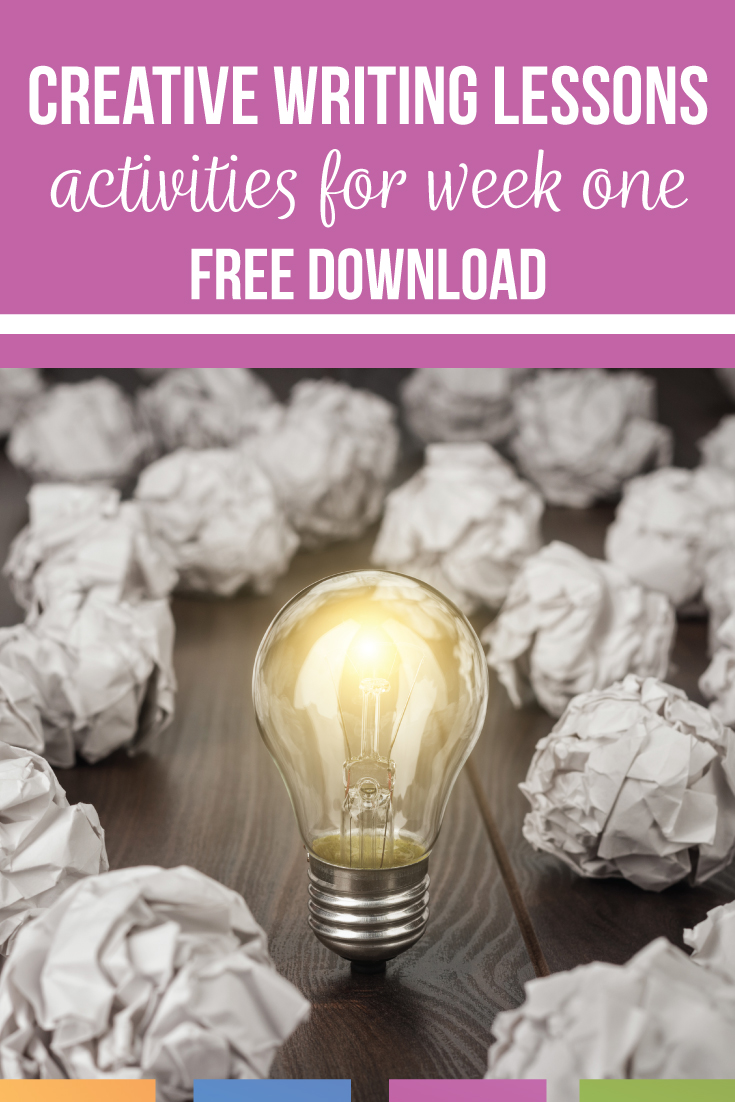
With about twenty minutes left in class, I ask students to form small groups. I want them to derive what makes these stories memorable. Since students complete group and partner activities in this class, I also watch and see how they interact.
Students often draw conclusions about what makes a story memorable:
- Realistic or true-to-life characters.
- Meaningful themes.
- Funny or sad events.
All of this information will be used later as students work on their own writing. Many times, my creative writing lessons overlap, especially concerning the feedback from young writers.

Creative Writing Lesson Day Three: Brainstorming and a graphic organizer
From building creative writing activities and implementing them, I now realize that students think they will sit and write. Ta-da! After all, this isn’t academic writing. Coaching creative writing students is part of the process.
Young writers must accept that a first draft is simply that, a first draft. Building a project requires thought and mistakes. (Any writing endeavor does, really.) Students hear ‘creative writing’ and they think… easy. Therefore, a first week lesson plan for creative writing should touch on what creativity is.
Really, creativity is everywhere. We complete a graphic organizer titled, “Where is Creativity?” Students brainstorm familiar areas that they may not realize have such pieces.
The ideas they compile stir all sorts of conversations:
- Restaurants
- Movie theaters
- Amusement parks
By completing this graphic organizer, we discuss how creativity surrounds us, how we can incorporate different pieces in our writing, and how different areas influence our processes.

Creative Writing Lesson, Days Four and Five: Creative Nonfiction
Students need practice writing, and they need to understand that they will not use every word they write. Cutting out lines is painful for them! Often, a lesson plan for creative writing involves providing time for meaningful writing.
For two days, we study and discuss creative nonfiction. Students start by reading an overview of creative nonfiction . (If you need mentor texts, that website has some as well.) When I have books available, I show the class examples of creative nonfiction.
We then continue through elements of a narrative . Classes are sometimes surprised that a narrative can be nonfiction.
The narrative writing is our first large project. As we continue, students are responsible for smaller projects as well. This keeps them writing most days.
Overall, my students and I work together during the first week of any creative writing class. I encourage them to write, and I cheer on their progress. My message to classes is that their writing has value, and an audience exists for their creations.
And that is my week one! The quick recap:
Week One Creative Writing Lesson Plans
Monday: Rules, procedures, TED Talk, discussion.
Tuesday: Prior knowledge—brainstorm the modeling of memorable stories. Draw conclusions about storytelling with anchor charts. Build community through common knowledge.
Wednesday: Graphic organizer.
Thursday and Friday: Creative nonfiction. Start narrative writing.
Students do well with this small assignment for the second week, and then we move to longer creative writing assignments . When classesexperience success with their first assignment, you can start constructive editing and revising with them as the class continues.
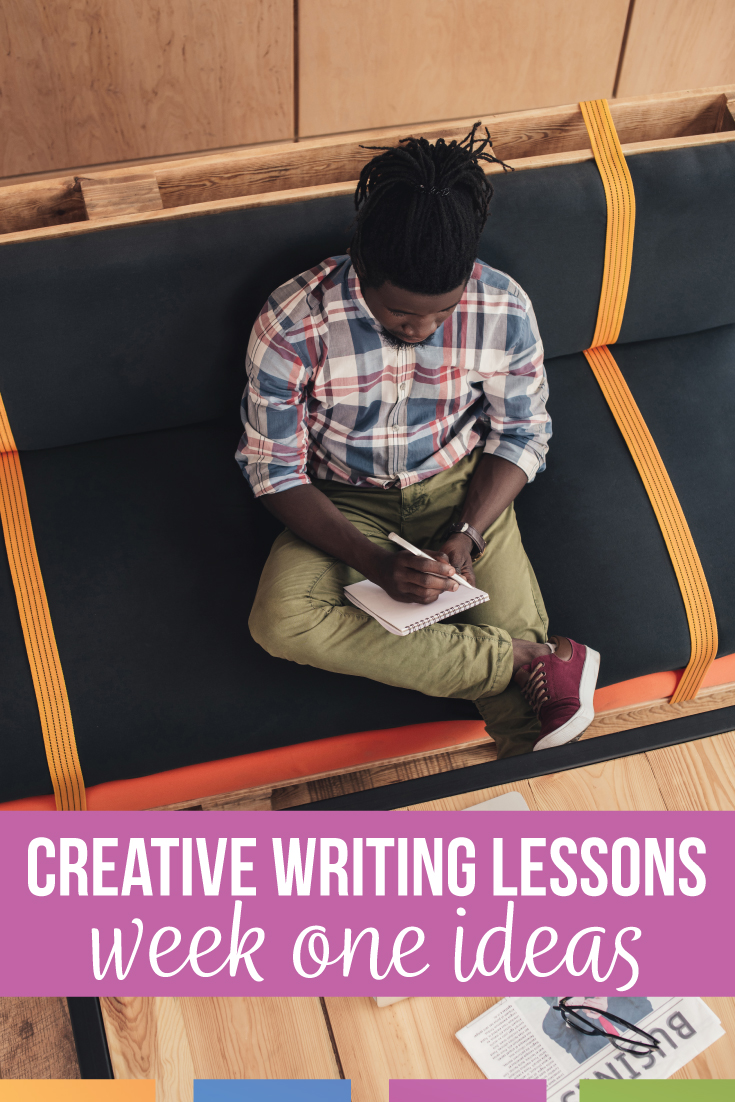
These creative writing activities should be easy implement and personalize for your students.
Would you like access to our free library of downloads?
Marketing Permissions
We will send you emails, but we will never sell your address.
You can change your mind at any time by clicking the unsubscribe link in the footer of any email you receive from us, or by contacting us at [email protected] . We will treat your information with respect. For more information about our privacy practices please visit our website. By clicking below, you agree that we may process your information in accordance with these terms.
We use Mailchimp as our marketing platform. By clicking below to subscribe, you acknowledge that your information will be transferred to Mailchimp for processing. Learn more about Mailchimp’s privacy practices.
Are you interested in more creative writing lesson ideas? My Facebook page has interactive educators who love to discuss creative writing for middle school and high school creative writing lesson plans. Join us!

creative writing creative writing activities
- Skip to primary navigation
- Skip to main content
- Skip to primary sidebar
Teaching Expertise
- Classroom Ideas
- Teacher’s Life
- Deals & Shopping
- Privacy Policy
51 Creative Writing Activities For The Classroom: Comics, Prompts, Games, And Pretend Play
January 4, 2024 // by Milka Kariuki
Creative writing can be tough for learners of any age. From knowing where to start to establishing the vocabulary to develop their story, there are a bunch of different skills they’ll need to perfect their creative writing pieces. There are so many creative writing activities out there, but which ones are best for your kiddos? Our list of 51 creative writing activities is the perfect place to start looking if you’ve got a creative writing unit coming up! Read on and see which ones might grab your little writers’ attention!
1. Make Your Own Comic Books
We bet your kiddos just love comic books! Let them create their very own in the style of the super popular Diary of a Wimpy Kid books! Encourage your students to come up with their own plot, dialogue, and illustrations to spark their creativity. Even your most reluctant writers will love this fun activity!
Learn More: Puffin Schools
2. Mad Libs
Using Mad Libs is a super popular way to develop your little creative writers! Use these free printables to get their creative juices flowing as they try to come up with words to fill the gaps to create weird and wonderful new stories. The best thing is that you can use these printables as many times as you like as their answers will be different each time!
Learn More: Teacher Vision
3. Flash Fiction
Flash fiction is a fantastic way to get your kiddies writing creatively while keeping things short and sweet! Use the range you prompts included in this resource to challenge them to write a creative story in less than 100 words. Flash fiction is amazing because your students won’t be overwhelmed by a huge writing task and it also means that your more confident writers will need to focus on the quality of their work, not the quantity!
Learn More: TES
4. Write a Story Based on the Ending
Test your students’ creativity by providing them with writing prompts that start at the end! In backward story writing, your budding writers will need to plan and pen a story that eventually leads to the ending you give them. This idea is a fantastic way to turn your traditional creative writing lesson on its head and in many ways take the pressure off your kids, as ending their stories is often the most difficult part for them!
Learn More: Teachers Pay Teachers
5. Found Poetry
Your learners will love this fun and creative found poetry activity. You can encourage them to collect words or a group of words from a favorite story or song then write them on a piece of paper or cut them out of a printed page. The overall goal is to have them rearrange the words differently to make an interesting poem with a unique writing style or genre!
Learn More: Homeschooling Ideas
6. Picture Dictionary
A picture dictionary is a brilliant way to support every member of your younger elementary class in their creative writing. The words paired with pictures give your writers a ‘dictionary’ that they can use pretty independently, so your less confident writers or non-native English-speaking students can still access your writing lessons!
Learn More: Twinkl
7. Creative Journal Writing
Why not start a creative journal with your kiddos? Have them engage in daily journaling activities by giving them a different creative prompt each day. For instance, write a story about what would happen if dogs took over the world or what would you do if you were the security guard at a zoo and someone stole an animal? The fun is never-ending with these prompts!
Learn More: Think Written
8. Roll a Story
Roll-a-Story is one of the best ways to help any of your kids who are suffering from a bout of writer’s block! They’ll roll the dice to discover the character, setting, and problem for their story then set to work weaving their creative tale! It could be a story about a wise doctor being chased by a mysterious creature in a casino, or maybe a rich artist losing their wallet in a library. Then it’s up to your students to fill in the gaps!
Learn More: TPT
9. Pass-it-on Story Writing
There’s no telling quite where this fun writing game will end up! Start by writing the first sentence of a story on a piece of paper then pass it around your class, having your kids come up with a sentence that continues the story. The paper is then passed around the whole class until every student has contributed. Finally, once it makes its way back to you, read out your collaborative story to the whole class!
Learn More: Minds In Bloom
10. Picture Writing Prompts
Creative writing prompts activities test not only your little ones’ imaginations but also their ability to craft a story and dialogue from that. Display an intriguing picture prompt for your class and have a discussion about it, recording their ideas. You could discuss what the person or animal in the picture is doing or what they’re thinking, where they think the picture was taken, and much more. They can use your collective notes to inspire their story!
Learn More: Pandora Post
11. What’s the Question?
What’s the Question is a simple, yet super engaging game that requires your young learners to think creatively. Spark their creativity by writing an answer on the whiteboard such as “the moon would explode,” and task your kiddos with coming up with a question to match it. There’ll be lots of laughs as everyone shares what they came up with!
Learn More: That Afterschool Life
12. Creative Writing Printables
This website is absolutely full of quick and fun graphics for children that’ll encourage their creative writing! The cute graphics and simple directions make it an easy bellringer activity for your writing class. Just print out some of these cool sheets and let your students get creative as they write thank-you notes to helpful heroes or finish little cartoon comics!
Learn More: Jarrett Lerner
13. Paint Chip Poetry
Nothing says creative writing quite like figurative language! Grab some of these free paint swatches from your local home improvement store and have your students create metaphors about their chosen color! We love this low-prep activity as once your kids have finished their poems, they’re a ready-made multi-colored display that’ll brighten the walls of your classroom!
Learn More: Fabulous In Fifth
14. Story Storm Activities
Once again, these Jarrett Lerner activities do not disappoint! Your students will have a blast pretending they are the principal for a day and they’ll get to create their very own rules for the school. Not only will this be an engaging writing exercise that we’re sure they’ll love getting creative with, but it also challenges children to think about why rules in school are important.
Learn More: Tara Lazar
15. Story Bag
Story bags are a fantastic way to destroy any kind of writer’s block! Grab an assortment of random objects from your home or classroom and pop them into the story bag. Next, gather your students around and pull out all the objects in the bag. Can they then write a story connecting all the items? Be sure to leave time to let them share their stories at the end of the lesson!
Learn More: Life Hack
16. Change the Ending
An easy way to ease your kiddos into the writing process is by having them rewrite part of a story. Grab their favorite read-aloud, and challenge them to come up with a new ending! They’ll need to finish the story in a way that makes sense, but aside from that, they can be as creative as they like! Your reluctant readers will like this one as much of the work on setting and characters has already been done!
Learn More: Make Beliefs Comix
17. Plot Twist Writing Prompts
BUT WAIT – there’s a twist…This fun writing practice is perfect for older middle or high school but could also be simplified for younger students. Write these twist prompts on notecards and have your kids draw one each before letting them go off and write a story around their chosen twist! They’ll be eager to share their finished work with classmates at the end. After all, who doesn’t love a good plot twist?
Learn More: Pinterest
18. Craft Box Craft
Every kid loves the book The Day the Crayons Quit for its creative narrative about this familiar box of coloring supplies! This extension activity rolls art and creative writing into one! Your students will have fun coming up with dialogue for each of the different crayons and you could even make it into a fun display for your classroom walls!
Learn More: Buggy And Buddy
19. Dialogue Pictures
Personalizing writing activities always makes it more engaging for kids! Print out a picture of yourself with a blank speech bubble, and model how to add in some dialogue. Then, let your kiddos practice speech bubbling with a photo of themselves, a pet, or a favorite celebrity, and have them come up with some interesting things for each of their subjects to say!
Learn More: SSS Teaching
20. Figurative Language Tasting
Your students will be creative writers in no time after practicing their figurative language with food tasting! Not only do tasty treats make this activity incredibly fun, but it also brings the writing process of metaphors and hyperbole to life. Just give each of your kids a few pieces of candy or snacks, and have them practice writing figures of speech relating to each one! They’ll have the words on the tip of their tongue- literally!
Learn More: It’s Lit Teaching
21. Explode the Moment
One of my favorite writing concepts as a teacher is ‘exploding the moment’. This method is perfect for showing your kiddies that even the smallest moment can be turned into an imaginative, descriptive story! Start by having them brainstorm some ideas and expand on tiny memories like losing a tooth, getting a pet, or making a winning goal in a soccer game!
Learn More: Raise The Bar Reading
22. Round-Robin Storytelling
Round-robin storytelling is the perfect collaborative creative writing activity! This one can be done verbally or in writing, and it challenges your class to build a story using a given set of words. They’ll have a fun and challenging time figuring out how to incorporate each piece into one cohesive story.
Learn More: Random Acts Of Kindness
23. Acrostic Poems
Acrostic poetry is one of the least intimidating creative writing exercises as there are no rules other than starting each line with the letter from a word. Challenge your kiddies to use each letter in their name to write lines of poetry about themselves, or they could choose to write about their favorite food or animal!
Learn More: Surfin’ Through Second
24. Sentence Sticks
This exercise requires minimal prep and can be used in so many different ways. All you’ll need are some craft sticks in which you will write sentences with blanks and word banks. Your young writers can then pull a stick and fill in the blanks to practice creative thinking! Task them with a different goal each time; can they make the sentence silly or sad for example?
Learn More: Liz’s Early Learning Spot
25. Conversation Prompts
These fun prompts require your kids to think creatively and answer a range of interesting questions. They’ll be excited to write stories about waking up with a mermaid tail or describe what is in a mystery package delivered to their doorstep! These creative prompts are perfect for bellringers or transitions throughout the school day!
Learn More: Twitter
26. Pretend Play Writing
Do you remember playing with fake money and fake food when you were younger? This idea takes it a step further by incorporating some writing practice! All you’ll have to do is print the templates for dollars, shopping lists, and recipes then let your little learners have fun with these play-pretend writing ideas!
Learn More: Prekinders
27. Question Cubes
Your class will be on a roll with these amazing question cubes! Whether the cubes are used for responding to a story, brainstorming the plot of a story, or practicing speech and listening, they are an easy, affordable tool for your little readers and writers! You can snag some foam dice at the dollar store and hot glue questions on each side to spark some creative writing ideas for your class.
Learn More: A Love 4 Teaching
28. Balderdash
Not only is Balderdash an addicting board game, but it can even be used in the classroom! Your little learners will have a blast as they create made-up, imaginative definitions for words, important people, and dates. Whoever guesses the real answer out of the mix wins the points!
Learn More: EB Academics
29. Two Sentence Horror Story
This creative writing exercise is best for older students and would be a great one to try out around Halloween! You’ll be challenging your learners to write a story that runs chills up their readers’ spines, but there’s a twist…the story can only be two sentences long! Your kiddos will love writing and sharing their writing to see who can come up with the spookiest short story!
30. Telephone Pictionary
Another game that your kids will be begging to play over and over again is telephone pictionary! The first player will write down a random phrase, and the next person must draw their interpretation of the phrase. The third player will write what they think the picture is and so on!
Learn More: Imagine Forest
31. Consequences
You need at least two players for this fun creative writing game. Each pair or group of kids will start by having one person write a random phrase and conceal it by folding the paper. Then, they pass it to the next student to fill in the blank using the prompt. Once all the blanks are filled in, let them unfold the paper and get ready to reveal some seriously silly stories!
32. Story Wands
Story wands are a fun way to have your kids respond to stories and study what makes something their favorite. Responding to what they’re reading is a super helpful exercise in preparing them for creative writing as it allows your students to connect to their favorite stories. By figuring out what elements make stories great, this is sure to help them in their own creative writing assignments!
Learn More: Little Lifelong Learners
33. The Best Part of Me
Probably my favorite creative writing activity, this one is infused with social-emotional learning and self-esteem building! Let your students get to choose their favorite physical characteristics about themselves; whether it be their eyes, hands, feet, etc. Then, they take a picture to attach to their written reasoning! Make sure to boost the creative element of this writing task by encouraging your learners to use a bunch of adjectives and some figurative language!
Learn More: Sarah Gardner Teaching
34. Me From A-Z
Challenge your kiddos to get creative by coming up with 26 different words to describe themselves! Me From A-Z gives your students the opportunity to explore who they are by coming up with words describing them in some way using each letter of the alphabet. Why not let them decorate their lists and turn them into a display celebrating the uniqueness of each of your class members?
35. How to Make Hot Chocolate
How-to writing is a great way to get the creative writing wheels turning in your kiddies’ brains! They’ll have a fun time coming up with their instructions and ways to explain how to make hot chocolate! Do they have a secret recipe that’ll make the best-ever hot cocoa!? Once they’ve written their instructions, be sure to try them out and do a taste-test of their recipes!
Learn More: Teacher Mama
36. Give Yourself a Hand
Hands up if you love this idea! For this creative writing activity, have your little ones trace their hand on a piece of paper and decorate it with accessories. Then, encourage them to write a list of all the different things they do with their hands all over their tracing! This is a great warm-up to get the creative gears turning.
Learn More: Write Now Troup
37. Word Picture Poem
A word picture poem is a fantastic way to challenge your kids to write descriptive poetry about a common object! Your little poets will learn to find beauty in ordinary things and strengthen their sensory language skills and their vocabulary. For some added fun, you can even task them with writing a short story about the item as well! The results are sure to be fun to read!
Learn More: Teaching With Terhune
38. Shape Poem
Shape poems are some of the most creative poetry as they combine words and art into one! First, your young poets can choose an object to use as their muse and lightly trace an outline onto some paper. Then, they’ll write words along the outlined shape in the form of a poem that describes the object! The result is a bunch of fun and striking poems that’ll look great displayed around your classroom!
39. Crazy Hair Poetry
Here’s another one that combines writing and art! Start by guiding your kiddos in drawing a self-portrait then adding some crazy hair by blowing watercolor paints around! After the paint dries, have your kids come up with a short but creative poem describing their hair art.
Learn More: Grade School Giggles
40. Fingerprint Poetry
Nothing is more creative than getting your kiddies to let down the barriers in their mind and tap into their stream of consciousness! Show them how to pick a topic and then let their words flow straight from mind to paper in a swirling pattern. This fingerprint idea can be used for a get-to-know-you activity as well!
Learn More: Kristen Dembroski
41. Doggie Haiku Poems
Put a fun twist on classic haiku poetry! Your students will have a paw-some time writing three-line poems about dogs which they can then illustrate afterwards! Before starting the activity, you can use Dogku by Andrew Clements as a read-aloud to get your class hooked on this idea!
Learn More: Teaching Fourth
42. Fractured Fairy Tale
Ever wondered if the Big Bad Wolf was framed? Or if Sleeping Beauty was actually a snorer? Your writers in training will have a fun time taking a classic fairytale and putting their own spin on it! Following five simple steps, your kids will be funky fairytale authors in no time!
43. Letter Writing
These creative letter-writing prompts are sure to boost your kiddies’ imaginative writing skills! Whether writing to a pen pal or a favorite celebrity, letter writing is a great way to practice handwriting, word flow, descriptive language, and communicating all rolled into one! Have your writers grab their pencils and let the creativity flow as they write fun response letters to these prompts!

44. Hersey’s Kisses Similes
Teach sensory language and similes by connecting this tasty treat with the sense of taste! Your students will have a lovely time brainstorming how chocolate connects to each of our senses and applying that knowledge by writing some sweet similies! What a fantastic way to teach them how to use these essential creative writing tools!
Learn More: Teacher By The Beach
45. Sensory Poetry
Another great way to teach sensory details is to have your learners write poems about their favorite foods! Task them with writing a line for each sense to describe the food! Everyone will be hungry after this creative writing lesson so it might be a good idea to have some snacks on hand!
Learn More: Mrs. Tice’s Class
46. Season Personification
Each season of weather has an array of characteristics making this the perfect activity to practice personification in creative writing! Allow your little writers to choose a season to write about as if it were a person with human characteristics. Winter is a no-brainer! It’s Elsa!
Learn More: Write Shop
47. Class Book of Character Traits
To be creative writers, your kids need to know how to create realistic characters for their stories. For this class book, you’ll start by giving each student two opposing character traits. Next, have them demonstrate these traits by illustrating two characters and displaying them through dialogue!
Learn More: Crafting Connections
48. Socialgrams
With Instagram being all the rage these days, your kiddos will have a fun time creating a ‘socialgram’ on paper! Challenge them to create a descriptive and engaging caption to go along with their “photo” in the post. Then, classmates can comment on each other’s work!
Learn More: Breezy Special Ed
49. Story Introduction Worksheets
Creative writing worksheets are a simple, minimal-prep tool to use in your creative writing units. Print out a variety of options, and have your kids practice their skills by finishing imaginative story introductions. By giving them a place to start their story, you can really take the pressure off your kids which will help ease them into the creative writing process!
Learn More: Lanternfish ESL
50. Dialogue Worksheets
Here’s another low-prep option for the last-minute planners! Pre-written dialogue can help guide the mood of the story and allow your kiddies to just focus on filling in the characters’ actions. This is also a great way to model how dialogue is spaced out and balanced in a story!
Learn More: ESL Writing Worksheets
51. Character Trait Posters
In this personalized character trait activity, your students will create a poster of themselves and label it with a bunch of different character traits. Descriptive, interesting characters are what make a story captivating, so this is a great introduction to understanding characters and their physical as well as personality traits! This is an activity that’s sure to help them build a strong foundation for their creative writing skills to build from!
Learn More: Life In First Grade
55 Creative Writing Activities and Exercises

Have you ever heard these questions or statements from your students?
- I don’t know where to begin.
- How can I make my story interesting?
- I’m just not creative.
- What should my story be about?
If so, you won’t want to miss these creative writing activities.
What Are Creative Writing Activities?
Activities that teach creative writing serve as drills to exercise your student’s writing muscle. When used effectively, they help reluctant writers get past that intimidating blank paper and encourage the words to flow.
When I think of creative writing exercises , writing prompts immediately come to mind. And, yes, writing from a prompt is certainly an example of a creative writing activity (a highly effective one).
However, writing prompts are only one way to teach creative writing. Other types of activities include games, collaboration with others, sensory activities, and comic strip creation to name a few.
Unlike writing assignments, creative writing activities aren’t necessarily meant to create a perfectly polished finished project.
Instead, they serve as more of a warmup and imagination boost.
Picture-based writing exercises are especially fun. You can download one for free below!

get this picture prompt printable for free!
How to use creative writing exercises effectively.
When teaching creative writing , the most effective exercises inspire and engage the student.
Remember that worn-out prompt your teacher probably hauled out every year?
“What I Did This Summer…”
Cue the groaning.
Instead of presenting your student with lackluster topics like that one, let’s talk about ways to engage and excite them.
For Kids or Beginners
Early writers tend to possess misconceptions about writing. Many picture sitting down for hours straight, polishing a story from beginning to end.
Even for experienced writers, this is next-to-impossible to do. It’s preconceived ideas like these that overwhelm and discourage students before they’ve even started.
Instead of assigning an essay to complete, start with simple, short writing exercises for elementary students such as:
- Creating comic strips using a template
- Talking out loud about a recent dream
- Writing a poem using rhyming words you provide
- Creating an acrostic from a special word
Creative writing exercises don’t have to end in a finished piece of work. If the exercise encouraged creative thinking and helped the student put pen to paper, it’s done its job.
For Middle School
Creative writing activities for middle school can be a little more inventive. They now have the fundamental reading and writing skills to wield their words properly.
Here are some ideas for middle school writing exercises you can try at home:
- Creating Mad Lib-style stories by changing out nouns, verbs, and adjectives in their favorite tales
- Storyboarding a short film
- Writing a family newsletter
- Creating crossword puzzles
For High School
Your high school student may be starting to prepare for college essays and other important creative writing assignments.
It’s more critical than ever for her to exercise her writing skills on a regular basis.
One great way to keep your high schooler’s mind thinking creatively is to have her make “listicles” of tips or facts about something she’s interested in already.
Another fun and effective creative writing exercise for high school is to have your student retell classic stories with a twist.
List of 55 Creative Writing Activities for Students of All Ages
No matter what age range your students may be, I think you’ll find something that suits their personality and interests in this list of creative writing ideas. Enjoy!
- Using only the sense of hearing, describe your surroundings.
- Write a paragraph from your shoes’ point of view. How do they view the world? What does a “day in the life of a shoe” look like?
- Imagine what the world will be like in 200 years. Describe it.
- Write a letter to someone you know who moved away. What has he or she missed? Should he or she move back? Why?
- Make up an imaginary friend. What does he or she look like? What does he or she like to do?
- Create a story about a person you know. Use as many details as possible.
- Write a poem that describes a place you have been.
- Soak up the season you’re in with seasonal creative writing prompts. Here are some ideas for fall and winter .
- Write a song where each line starts with the next letter in the alphabet.
- Create a list of words related to something you love.
- Write a short story based on a true event in your life.
- Rewrite a chapter of your favorite book from the antagonist’s point of view.
- Write a letter to your future self. What do you want to make sure you remember?
- Go on a five-senses scavenger hunt. Find three items for each sense. Create a story using the items you found.
- Create a story around an interesting picture ( try these fun picture writing prompts! )
- Find an ad in a magazine or elsewhere and rewrite the description to convince people NOT to buy the advertised item.
- Write a story using the last word of each sentence as the first word of the next.
- Describe everything you’re sensing right now, using all five senses.
- Write a list of animals A to Z with a one-sentence description of each one. Feel free to include imaginary animals.
- Design your dream room in detail.
- Write a script of yourself interviewing a famous person. Include his or her answers.
- Describe what high school would be like if you lived on the moon. What would you be learning about? How would you be learning it?
- Describe a day in the life of a famous person in history. Include both mundane and exciting details of things they may have experienced on a normal day.
- Pick up something on a bookshelf or end table nearby. Now write a commercial script for it to convince your audience that they absolutely must own this thing.
- Plan a birthday party for your best friend. Describe the decorations, food, and everything else.
- Write a very short story about three siblings fighting over a toy. Now rewrite it twice, each time from a different character’s perspective.
- Tell a story from the point of view of a pigeon on a city street.
- Create a menu for a deli you’ll be opening soon. Name each sandwich after something or someone in real life and list the fillings and type of bread.
- Pretend you just became famous for something. Write 3 exciting newspaper headlines about the topic or reason behind your newfound fame.
- Keep a one-line-a-day journal. Every day, write down one thought or sentence about something that happened that day or how you felt about the day.
- Have you ever had a nightmare? Write what happened but with a new ending where everything turns out okay (perhaps the monster was your dad in a costume, preparing to surprise you at your birthday party).
- Write a “tweet” about something that happened to you recently, using only 140 characters.
- Take an important event in your life or the life of someone in your family. Write one sentence answering each of the 6 journalistic questions: Who, What, When, Where, Why, and How.
- Set a timer for 5 minutes and write nonstop, starting with the words “I remember.” If you get stuck, write “I remember” again until you get unstuck.
- Pick something you use often (a toothbrush, your desk, etc). Then tell the story of how it was invented. If you don’t know, make something up.
- Choose a princess or hero and write a one-paragraph story about him or her traveling to a distant land.
- Pretend you are a tour guide for a local attraction. It can be a library, a park, or a museum, but it could also be a place that wouldn’t normally hold tours (such as an arcade). Write a speech about what you tell your tour group as you walk around the attraction.
- Create a marketing brochure for your favorite activity or fun place to go.
- Make a list of 10 future story settings. Write one sentence describing each. For example, “ in the dark, musty cellar of my grandmother’s house, surrounded by dried-up jars of canned peaches… ”
- Make a list of foods included in a dinner party catered by the world’s worst cook, describing how each course looks, smells, and tastes. Include your reactions while eating it.
- Write out your own version of instructions for playing your favorite game.
- Pretend you’ve lost your sight for one night. Describe going out to eat at a restaurant, using smells, textures, and sounds to tell your story.
- Write a script for an interesting phone conversation in which the reader can only hear one side.
- Tell the story of an object someone threw away from the perspective of the person who tossed it out. Then tell the story of that same object from the perspective of a person who finds it and deems it a treasure.
- List your 3 least favorite chores. Pick one and write a one paragraph detailing why you can’t possibly complete that chore ever again.
- Write an excerpt from your dog’s diary (pretend he keeps one).
- Write the script for a movie trailer—real or imagined.
- Create an acrostic for a holiday of your choice.
- Pretend you’re the master of a role-playing game, describing a sticky situation in which the other players now find themselves. Describe the scenario in writing.
- Compose a funny or dramatic caption for a photo.
- Parents, place a textured object in a box without letting your student see it. Have him or her reach in, touch the object, and then describe how it feels.
- Write lyrics for a parody of a song.
- Make a list of 10-20 songs that would be played if a movie was made about your life.
- Describe the sounds, smells, sights, and textures you’d experience if you went to the beach for the day.
- Write an election speech with ludicrous and impossible campaign promises.
One of the best ways to encourage students to write regularly is by providing fun creative writing activities .
They serve to encourage both the habit and mindset of writing with imagination. If you need extra help with that, check out Creative Freewriting Adventure :
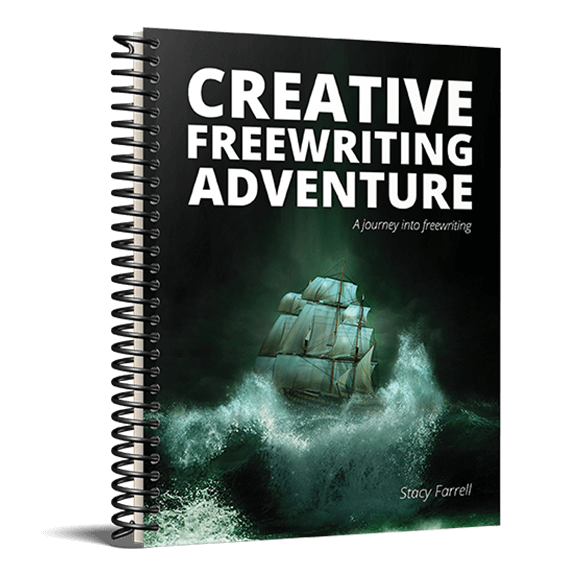
bring excitement into your student’s writing – no prep required!
About the author.
Jordan Mitchell
- Grades 6-12
- School Leaders
Get our mega Halloween worksheets bundle! 👻
10 Creative Writing Activities That Help Students Tell Their Stories
Lower the stakes and help them get started.

“I don’t have a story. There’s nothing interesting about my life!” Sound familiar? I don’t know a teacher who hasn’t heard students say this. When we ask our students to write about themselves, they get stuck. We know how important it is for them to tell their own stories. It’s how we explore our identities and keep our histories and cultures alive. It can even be dangerous when we don’t tell our stories (check out this Ted Talk given by novelist Chimamanda Ngozi Adichie and share it with your students for more on that). Storytelling is essential for every subject, not just English Language Arts; students dive deeper and engage when they practice thinking about how their own stories intersect with historical events, civic engagement, and the real-world implications of STEM. These 10 creative writing activities can work in every subject you teach:
Here are 10 of our favorite story telling activities that inspire students:
1. write an “i am from” poem.
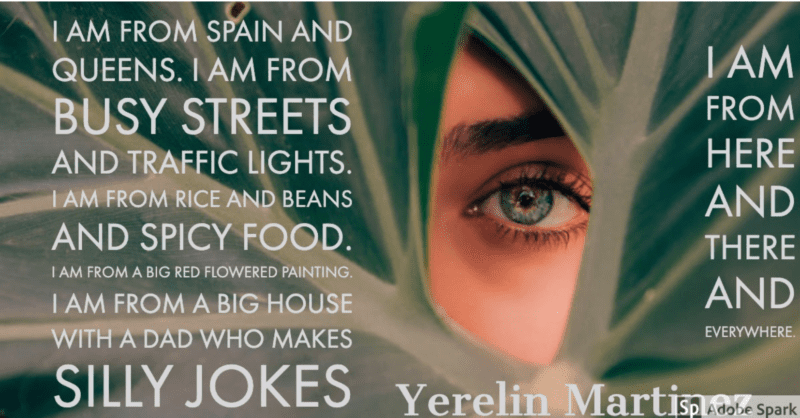
Students read the poem “I am From” by George Ella Lyon. Then, they draft a poem about their own identity in the same format Lyon used. Finally, students create a video to publish their poems. We love this one because the mentor text gives a clear structure and example that students can follow. But the end result is truly unique, just like their story.
2. Design a social media post to share an important memory
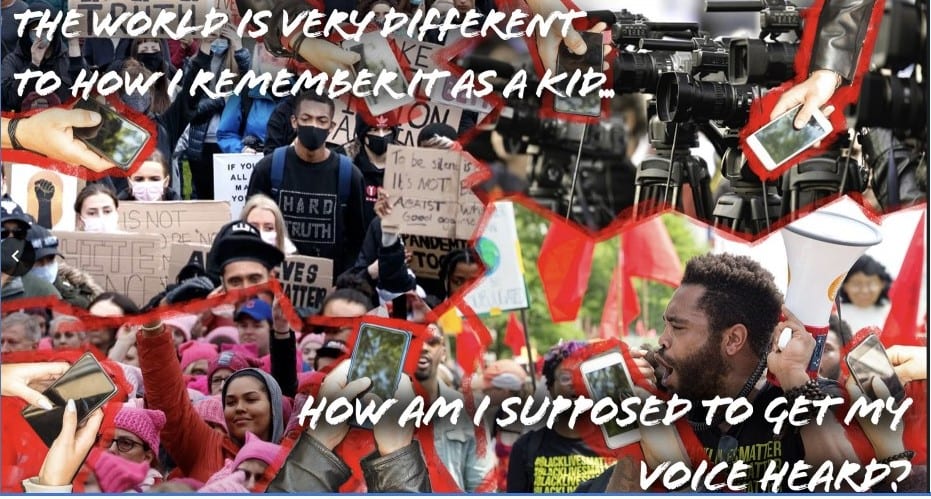
How can you use your unique perspective to tell a story? We want our students to learn that they are truly unique and have stories that only they can tell that other people want to hear or could relate to or learn from. In this activity, students watch two Pixar-in-a-Box videos on Khan Academy to learn about storytelling and perspective. Then, they identify an interesting or poignant memory and design a social media post.
3. Create an image using a line to chart an emotional journey
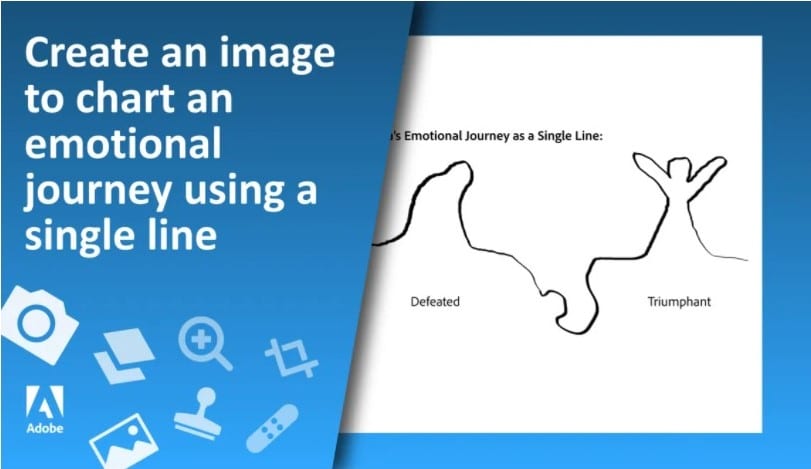
How do you show emotion using a single line? In this activity, students watch a Pixar in a Box video on Khan Academy to learn about how lines communicate character, emotion, and tension. Then they experiment with these aspects as they write their story. We love using this for pre-writing and to help students explore their story arc. Also, for students who love to draw or learn visually, this can help them get started telling their story and show them that there are many different ways to tell a story.
4. Tell the story behind your name
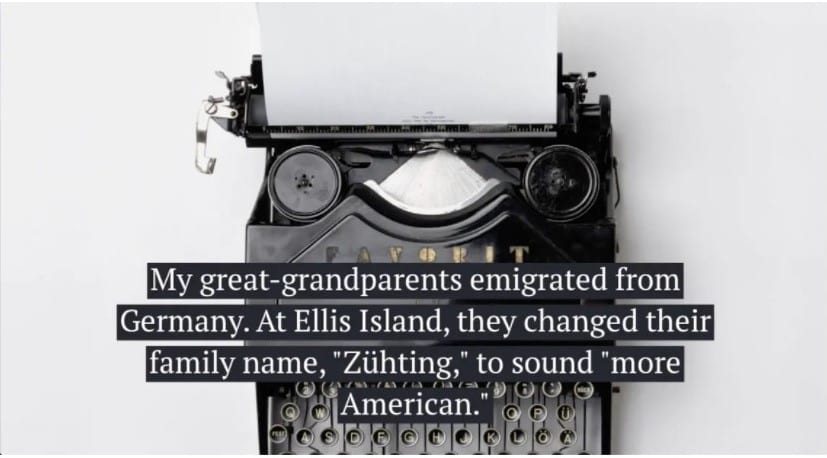
Sharing the story behind our name is a way to tell a story about ourselves, our culture, and our family history. And if there isn’t a story behind it, we can talk about how we feel about it and describe what it sounds like. In this activity, students use video to introduce themselves to their classmates by discussing the origin of their name. This project asks students to connect their names (and identities) to their personal and familial histories and to larger historical forces. If you’re looking for a mentor text that pairs well with this one, try “My Name” by Sandra Cisneros .
5. Develop a visual character sketch
Give students the time to create a character sketch of themselves. This will help them see how they fit into their story. In this lesson, students create a visual character sketch. They’ll treat themselves like a character and learn to see themselves objectively.
6. Create a webpage to outline the story of your movie

Building a story spine is a great way to show students how to put the parts of their story in an order that makes sense. It’s an exercise in making choices about structure. We like this activity because it gives students a chance to see different examples of structure in storytelling. Then, they consider the question: how can you use structure to set your story up for success? Finally, they design and illustrate an outline for their story.
7. Respond to a variety of writing prompts
Sometimes our students get stuck because they aren’t inspired or need a different entry point into telling their story. Give them a lot of writing prompts that they can choose from. Pass out paper and pencils. Set a timer for fifteen minutes. Then, write 3-4 writing prompts on the board. Encourage students to free-write and not worry about whether their ideas are good or right. Some of our favorite prompts to encourage students to tell their story are:
- I don’t know why I remember…
- What’s your favorite place and why?
- What objects tell the story of your life?
- What might surprise someone to learn about you?
8. Create a self-portrait exploring identity and self-expression
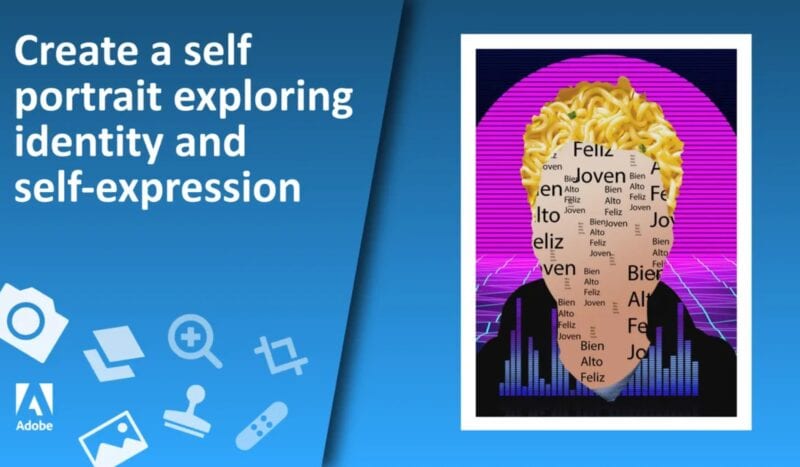
Part of what makes writing your own story so difficult for students is that they are just building their identity. In this activity, students explore how they and others define their identity. What role does identity play in determining how they are perceived and treated by others? What remains hidden and what is shown publicly?
9. Film a video to share an important story from your life

Encourage students to think about how to tell the story of a day they faced their fears. Students consider the question: How can you use different shot types to tell your story? They watch a video from Pixar in a Box on Khan Academy to learn about different camera shots and their use in storytelling. Then, they use Adobe Spark Post or Photoshop and choose three moments from their story to make into shots. We love using this to help students think about pace and perspective. Sometimes what we leave out of our story is just as important as what we include.
10. Try wild writing
Laurie Powers created a process where you read a poem and then select two lines from it. Students start their own writing with one of those lines. Anytime that they get stuck, they repeat their jump-off line again. This is a standalone activity or a daily writing warm-up, and it works with any poem. We love how it lowers the stakes. Can’t think of anything to write? Repeat the jump-off line and start again. Here are some of our favorite jump-off lines:
- The truth is…
- Some people say…
- Here’s what I forgot to tell you…
- Some questions have no answers…
- Here’s what I’m afraid to write about…
You Might Also Like
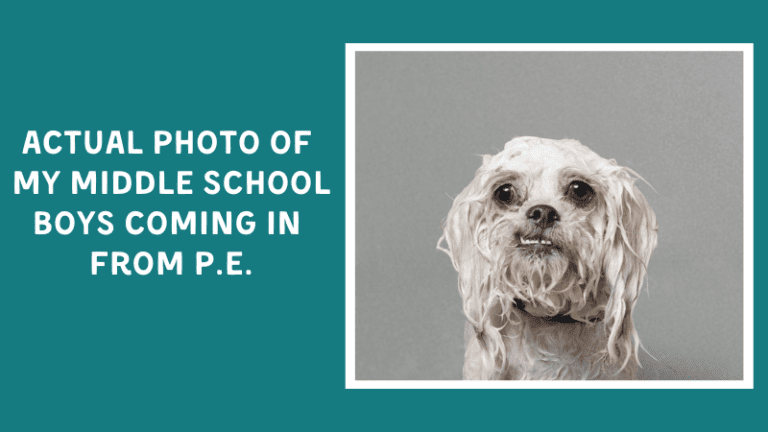
19 Memes Capturing the Reality of Teaching Middle School
Because teaching middle school can get ... interesting. Continue Reading
Copyright © 2024. All rights reserved. 5335 Gate Parkway, Jacksonville, FL 32256
You are using an outdated browser. Please upgrade your browser to improve your experience.
How to Teach Creative Writing | 7 Steps to Get Students Wordsmithing

“I don’t have any ideas!”
“I can’t think of anything!”
While we see creative writing as a world of limitless imagination, our students often see an overwhelming desert of “no idea.”
But when you teach creative writing effectively, you’ll notice that every student is brimming over with ideas that just have to get out.
So what does teaching creative writing effectively look like?
We’ve outlined a seven-step method that will scaffold your students through each phase of the creative process from idea generation through to final edits.
7. Create inspiring and original prompts
Use the following formats to generate prompts that get students inspired:
- personal memories (“Write about a person who taught you an important lesson”)
- imaginative scenarios
- prompts based on a familiar mentor text (e.g. “Write an alternative ending to your favorite book”). These are especially useful for giving struggling students an easy starting point.
- lead-in sentences (“I looked in the mirror and I couldn’t believe my eyes. Somehow overnight I…”).
- fascinating or thought-provoking images with a directive (“Who do you think lives in this mountain cabin? Tell their story”).
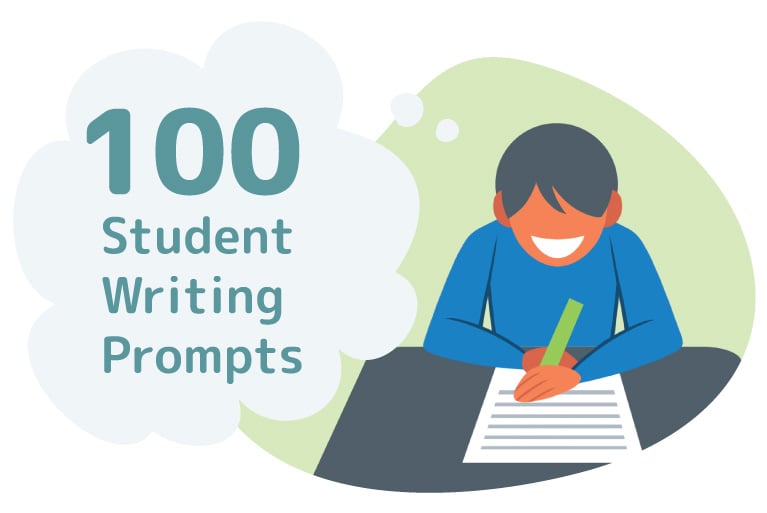
Don’t have the time or stuck for ideas? Check out our list of 100 student writing prompts
6. unpack the prompts together.
Explicitly teach your students how to dig deeper into the prompt for engaging and original ideas.
Probing questions are an effective strategy for digging into a prompt. Take this one for example:
“I looked in the mirror and I couldn’t believe my eyes. Somehow overnight I…”
Ask “What questions need answering here?” The first thing students will want to know is:
What happened overnight?
No doubt they’ll be able to come up with plenty of zany answers to that question, but there’s another one they could ask to make things much more interesting:
Who might “I” be?
In this way, you subtly push students to go beyond the obvious and into more original and thoughtful territory. It’s even more useful with a deep prompt:
“Write a story where the main character starts to question something they’ve always believed.”
Here students could ask:
- What sorts of beliefs do people take for granted?
- What might make us question those beliefs?
- What happens when we question something we’ve always thought is true?
- How do we feel when we discover that something isn’t true?
Try splitting students into groups, having each group come up with probing questions for a prompt, and then discussing potential “answers” to these questions as a class.
The most important lesson at this point should be that good ideas take time to generate. So don’t rush this step!
5. Warm-up for writing
A quick warm-up activity will:
- allow students to see what their discussed ideas look like on paper
- help fix the “I don’t know how to start” problem
- warm up writing muscles quite literally (especially important for young learners who are still developing handwriting and fine motor skills).
Freewriting is a particularly effective warm-up. Give students 5–10 minutes to “dump” all their ideas for a prompt onto the page for without worrying about structure, spelling, or grammar.
After about five minutes you’ll notice them starting to get into the groove, and when you call time, they’ll have a better idea of what captures their interest.
Did you know? The Story Factory in Reading Eggs allows your students to write and publish their own storybooks using an easy step-by-step guide.

4. Start planning
Now it’s time for students to piece all these raw ideas together and generate a plan. This will synthesize disjointed ideas and give them a roadmap for the writing process.
Note: at this stage your strong writers might be more than ready to get started on a creative piece. If so, let them go for it – use planning for students who are still puzzling things out.
Here are four ideas for planning:
Graphic organisers
A graphic organiser will allow your students to plan out the overall structure of their writing. They’re also particularly useful in “chunking” the writing process, so students don’t see it as one big wall of text.
Storyboards and illustrations
These will engage your artistically-minded students and give greater depth to settings and characters. Just make sure that drawing doesn’t overshadow the writing process.
Voice recordings
If you have students who are hesitant to commit words to paper, tell them to think out loud and record it on their device. Often they’ll be surprised at how well their spoken words translate to the page.
Write a blurb
This takes a bit more explicit teaching, but it gets students to concisely summarize all their main ideas (without giving away spoilers). Look at some blurbs on the back of published books before getting them to write their own. Afterward they could test it out on a friend – based on the blurb, would they borrow it from the library?
3. Produce rough drafts
Warmed up and with a plan at the ready, your students are now ready to start wordsmithing. But before they start on a draft, remind them of what a draft is supposed to be:
- a work in progress.
Remind them that if they wait for the perfect words to come, they’ll end up with blank pages .
Instead, it’s time to take some writing risks and get messy. Encourage this by:
- demonstrating the writing process to students yourself
- taking the focus off spelling and grammar (during the drafting stage)
- providing meaningful and in-depth feedback (using words, not ticks!).

Reading Eggs also gives you access to an ever-expanding collection of over 3,500 online books!
2. share drafts for peer feedback.
Don’t saddle yourself with 30 drafts for marking. Peer assessment is a better (and less exhausting) way to ensure everyone receives the feedback they need.
Why? Because for something as personal as creative writing, feedback often translates better when it’s in the familiar and friendly language that only a peer can produce. Looking at each other’s work will also give students more ideas about how they can improve their own.
Scaffold peer feedback to ensure it’s constructive. The following methods work well:
Student rubrics
A simple rubric allows students to deliver more in-depth feedback than “It was pretty good.” The criteria will depend on what you are ultimately looking for, but students could assess each other’s:
- use of language.
Whatever you opt for, just make sure the language you use in the rubric is student-friendly.
Two positives and a focus area
Have students identify two things their peer did well, and one area that they could focus on further, then turn this into written feedback. Model the process for creating specific comments so you get something more constructive than “It was pretty good.” It helps to use stems such as:
I really liked this character because…
I found this idea interesting because it made me think…
I was a bit confused by…
I wonder why you… Maybe you could… instead.
1. The editing stage
Now that students have a draft and feedback, here’s where we teachers often tell them to “go over it” or “give it some final touches.”
But our students don’t always know how to edit.
Scaffold the process with questions that encourage students to think critically about their writing, such as:
- Are there any parts that would be confusing if I wasn’t there to explain them?
- Are there any parts that seem irrelevant to the rest?
- Which parts am I most uncertain about?
- Does the whole thing flow together, or are there parts that seem out of place?
- Are there places where I could have used a better word?
- Are there any grammatical or spelling errors I notice?
Key to this process is getting students to read their creative writing from start to finish .
Important note: if your students are using a word processor, show them where the spell-check is and how to use it. Sounds obvious, but in the age of autocorrect, many students simply don’t know.
A final word on teaching creative writing
Remember that the best writers write regularly.
Incorporate them into your lessons as often as possible, and soon enough, you’ll have just as much fun marking your students’ creative writing as they do producing it.
Need more help supporting your students’ writing?
Read up on how to get reluctant writers writing , strategies for supporting struggling secondary writers , or check out our huge list of writing prompts for kids .

Watch your students get excited about writing and publishing their own storybooks in the Story Factory
You might like....
Creative Writing Lesson Plans: From Paragraphs to Narratives
Return from Creative Writing Lesson Plans to Creative Writing Ideas and Activities
Would you prefer to share this page with others by linking to it?
- Click on the HTML link code below.
- Copy and paste it, adding a note of your own, into your blog, a Web page, forums, a blog comment, your Facebook account, or anywhere that someone would find this page valuable.
Helping You Write Across the Curriculum!
copyright 2009-2013 www.creative-writing-ideas-and-activities.com
- Writing Topics
- Writing Prompts
- Writing Ideas
- Writing Activities
- Lesson Plans
- Writing Tips
- Privacy Policy
Our Most Popular Pages
1. Teaching Resources
2. How to Write a Myth
3. February Writing Prompts
4. How to Write a Legend
5. Writing a Personal Narritive
6. Writing Fables
7. Writing Mystery Stories
8. Math Prompts
9. Science Writing Prompts
10. Elements of Persuasive Writing
Recommeded Resources:
AnyWord(TM) Spelling Practice Series!
Worksheets, games and activities to use with any spelling words. Three volumes in all!
Download yours today!
Stop Essay Pain!
LitWorks.com
Resources to help students prepare for literature examinations.
Teach Kids Drama!
Walking by the Way
the road to inspired learning
Engaging Creative Writing Lessons for Your Students
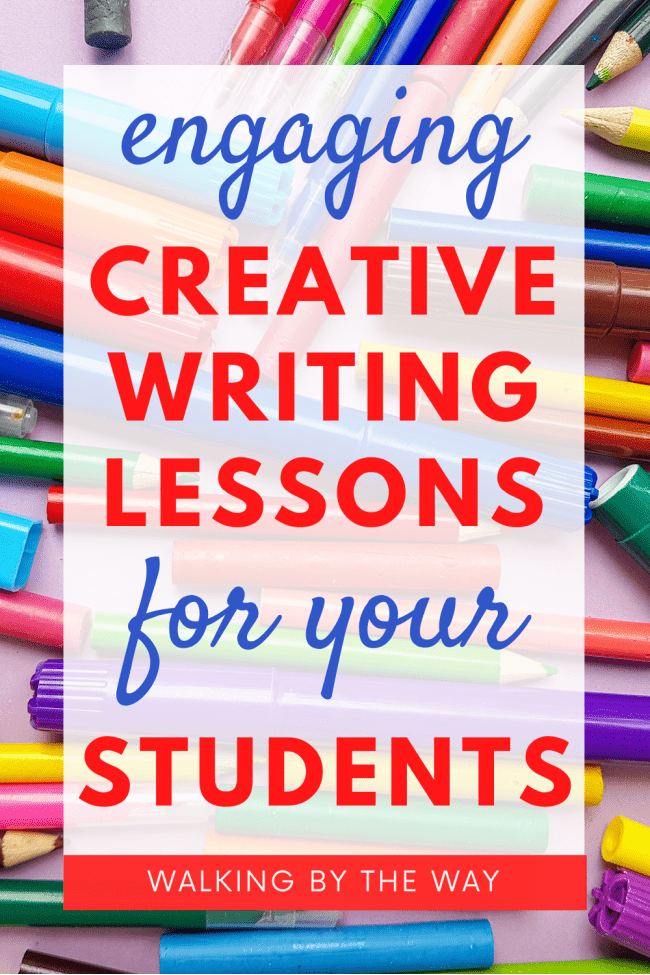
I often hear students protest, “But I’m not creative.” And moms look at me with a shoulder shrug and a mirror claim, “I’m not creative either.”
I don’t buy in.
We have been gifted with a creativity muscle. It’s just that it doesn’t work properly if it hasn’t been exercised.
As I design creative writing lessons , my goal is to provide you with engaging, hands-on activities–creative writing exercises to keep your students smiling, laughing, and moving that yellow pencil (or purple marker!) across the page.
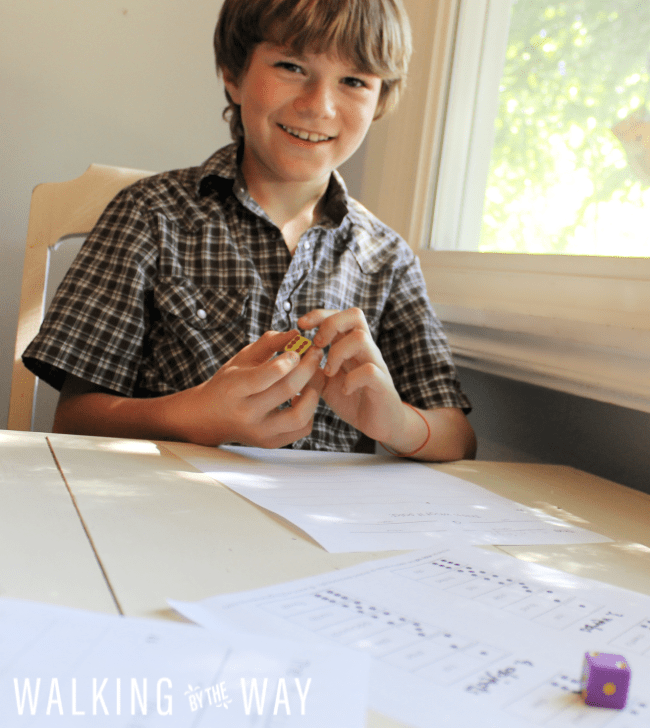
The Importance of Creative Writing
Why should you care about creative writing? Because creative writers are creative thinkers.
Creative thinkers are resourceful problem-solvers. They aren’t afraid to try new things as their curiosity leads them to experiment. Creative thinkers gain emotional intelligence as they explore their own thoughts and feelings, the thoughts and feelings of others, and the big, big world around them.
Creative writing doesn’t have to be hard, scary, or dreadful. I promise. I’m here to help you deliver interesting, enjoyable lessons to your students.
Browse the lessons below to find the just-right creative writing activity for your students.
Creative Writing Lessons and Activities for Early Elementary
Character Sketch: My Pet Dragon Even young students can write a character sketch with this guided writing activity. Students fill out the pet dragon form and then write a short sketch using the information on the form.
Christmas Story Writing Prompts Flip, flap, and mix until you find a setting, characters, and conflict you want to use for your short story.
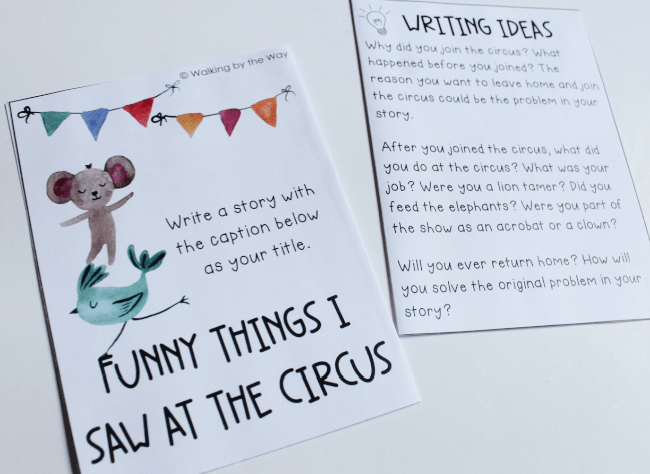
Circus Writing Prompt Cards This set of writing prompt cards is great for kids who need help generating ideas. The prompts are questions. As the students answer the questions, they will have ample ideas for writing a circus themed story.
Creative Writing Activities for Kids This group of activities from other bloggers will provide you with lots of new ideas for your students.
Creative Writing Dice Game You can partner with your student for this fun dice game; it is the perfect remedy for students who balk at pushing their pencils.
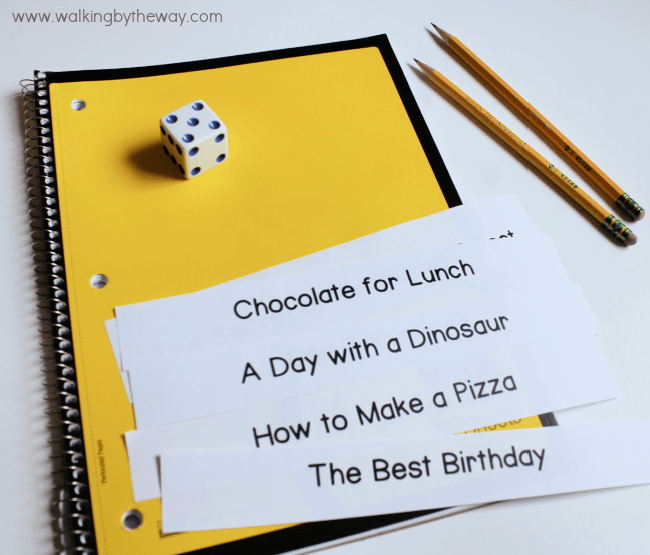
Design a Circus Poster Creative Writing Activity Another great activity for reluctant writers; the circus poster only includes a tiny bit of writing, but a great bit of creating thinking.
Dialogue Lesson Plan for Young Writers Introduce the importance of dialogue with This Is Not My Hat by Jon Klassen. This lesson also includes a hands-on dice writing game that helps students write their own dialogue examples.
Dinosaur Creative Writing Prompts This set of writing prompts will help your student write a paragraph or journal entry about dinosaurs.
Dinosaur Writing Prompt Cards This set of writing prompt cards will motivate your student to write a dinosaur themed short story. The cards are structured in a way to help your student generate gobs of ideas for a short story.
Fairy Tale Writing Prompts Inspire your student to write with fairy tale settings, objects, and characters.
Halloween Story Writing Prompts Write spooky stories with this set of flip, mix, and match strips. Students are given various options for settings, characters, and conflicts.
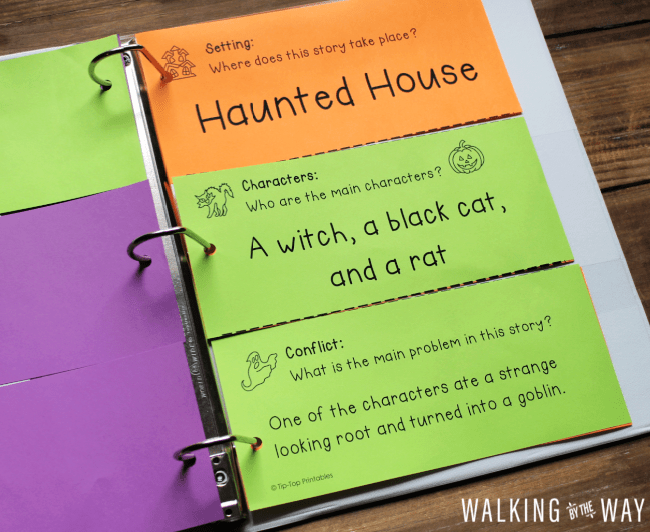
Hot Air Balloon Writing Prompt Cards If your student complains about not knowing what to write about, try this set of adventure themed writing prompt cards. You can easily guide your student through the writing process with these prompts.
Imaginary Animals Writing Activity Even young students in kindergarten and first grade can enjoy a creative writing lesson. Your students will love creating crazy animals with playdough and using the writing form to compose simple paragraphs.
Listmaking Writing Prompts Students may not be ready to write sentences or paragraphs, but you can entice them to make lists with these engaging prompts.
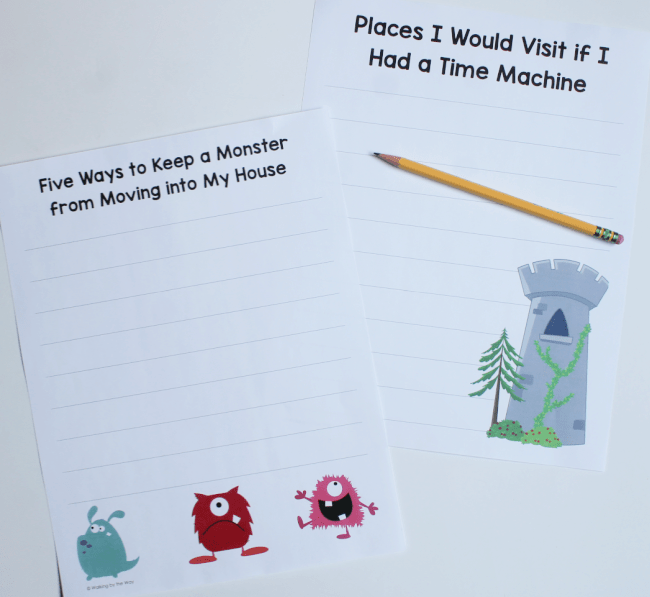
Mad Science: Adjectives Writing Lab First, students will imagine wonderful and strange things hissing and fizzing in a mad scientist’s lab. Next, students will name and write a description for each item. Finally, students will use their descriptions to write paragraphs about the mad scientist’s lab.
Monster Creative Writing Prompt Cards Boost your student’s imagination with these monster creative writing prompts. You can use these for paragraph writing or journal entries; some of the prompts might even lead to short stories.
Mystery Writing Prompts Do you have a super sleuth? Let your detective try writing some mystery stories using these prompts.
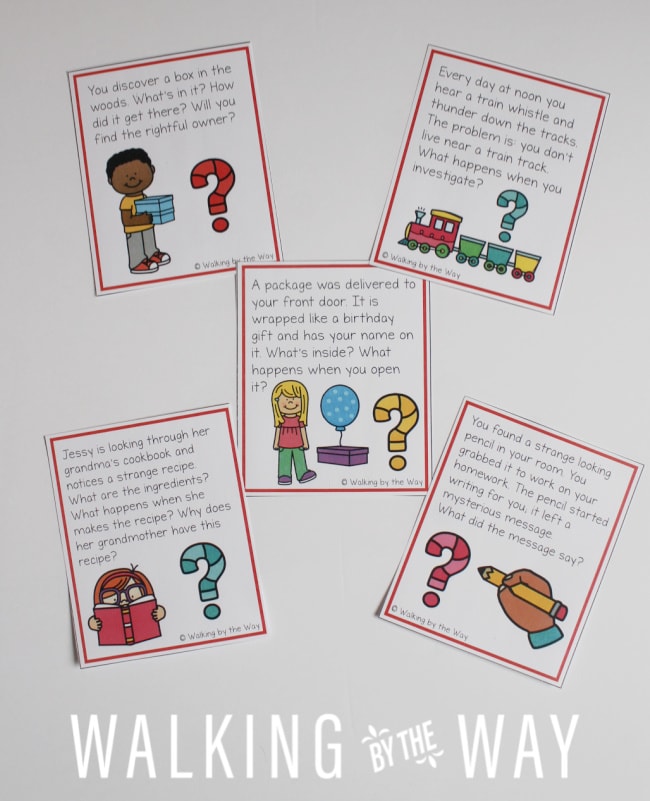
Nurture Creative Thinking with Wordless Books The precursor to creative writing is creative thinking. This activity, designed to build your student’s creative thinking skills, is based on Aaron Becker’s wordless books, Journey and Quest .
Pet Picture Writing Prompts I love using pictures for prompts! Grab this set of free pet pictures and use some of the ideas in the post to get your students writing about pets.
Pirate Writing Prompts It’s a pirate’s life with these fun prompts. Print and cut out the cards. Laminate and put them on a ring and let your student pick one and write.
Teach Parts of a Story with a Picture Book Use Help! We Need a Title! by Herve Tullet to teach your student about author, title, characters, setting, conflict, and resolution.
Super Hero Writing Prompts Save the day with these fun prompts for your students.
Thanksgiving Dice Writing Activity Your students will laugh out loud as they create silly sentences about Thanksgiving.
Use a Picture Book Teach the Story Element of Conflict The Pencil by Allan Ahlberg is a fantastic base for teaching how to add conflict and resolution to a short story. Use the lesson and game to teach it to your students.
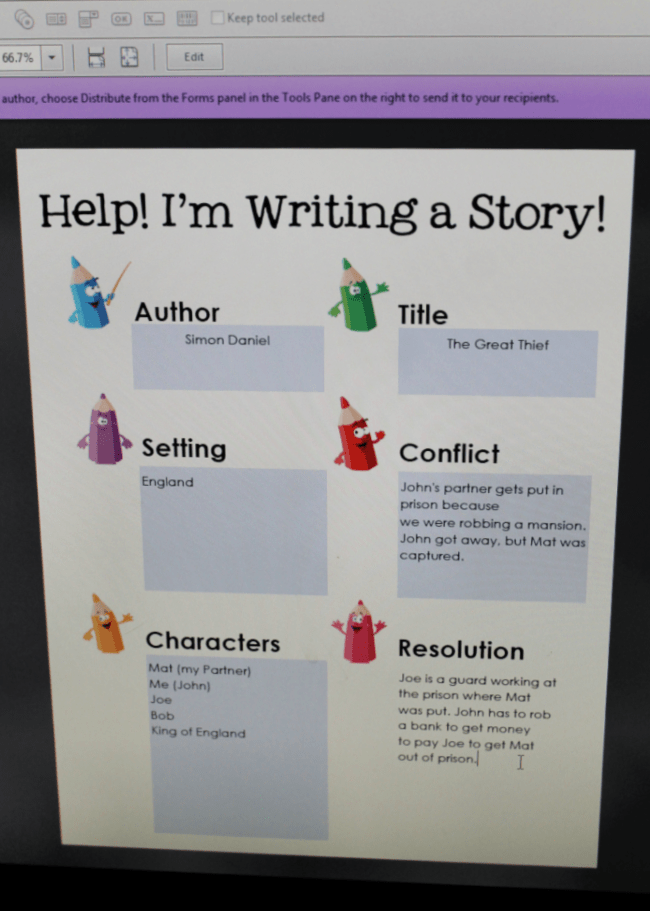
Writing Activity for Sam and Dave Dig a Hole: Make a List Use the book Sam and Dave Dig a Hole to inspire your student to create a fun (and funny!) list.
Write Backstories for Fairy Tale Characters Have you ever wondered what Rapunzel was doing before she got trapped in that tower? Or what about Goldilocks? What was she doing before she invaded the Three Bears’ house? Explore all kinds of writing possibilities with this fun creative writing lesson.
You can also find an assortment of creative writing lessons and activities for elementary students in the Tip-Top Printables Shop .
Creative Writing Lessons and Activities for Upper Elementary
Pictures to Inspire Creative Writing If you are looking for an easy way to boost interest in creative writing, try this simple activity.
Pourquoi Tales Writing Lesson Why does the leopard have spots? How did the bear lose its tail? Let your students build their creative thinking skills while composing pourquoi tales with this lesson plan.
Creative Writing Lessons for a Homeschool Co-op
I taught this series of posts for a local homeschool co-op, but you can use them however you want.
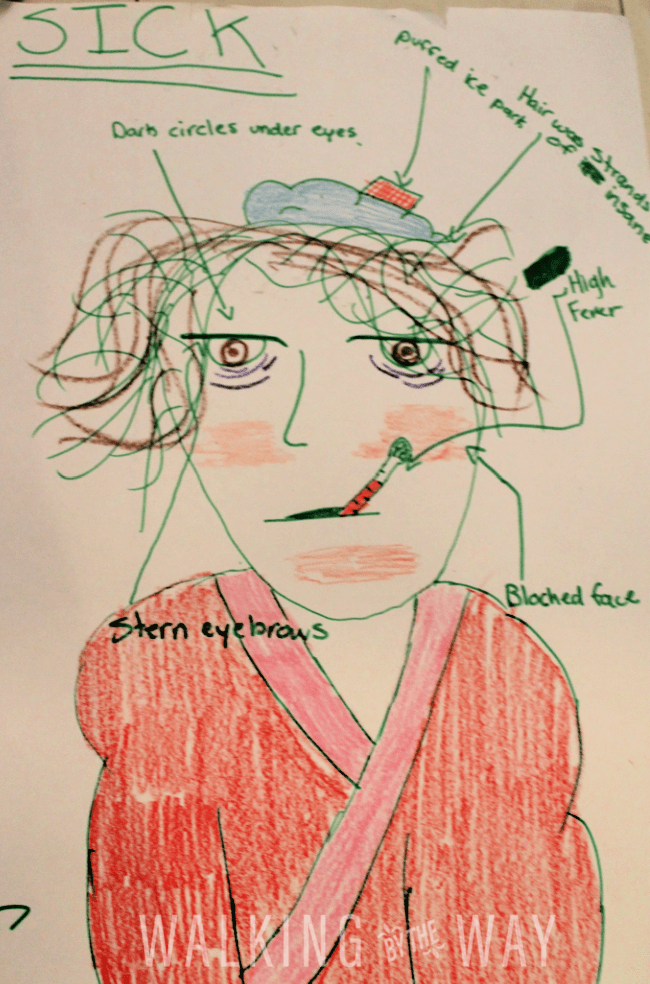
Creative Writing Lesson One: Cliché and Metaphor Students learn the importance of words with this lesson–including how to avoid clichés and what makes a great metaphor.
Creative Writing Lesson Two: Sensory Details Students consider how a reader experiences the world through writing and how sensory details are a key part of that experience.
Creative Writing Lesson Three: Showing vs. Telling Students learn how to recognize authors who utilize showing, and students will be able to articulate the difference between showing and telling.
Creative Writing Lesson Four: Capturing Images Image is essential. Students learn why images are necessary and how to capture their own.
Creative Writing Lesson Five: Character and Conflict Introduce character and conflict and why these story elements are vital for short story writers.
Creative Writing Lesson Six: Point of View Students learn about point of view and then enjoy reading poems and using pictures to write descriptions from different points of view (and perspectives).
Creative Writing Lesson Seven: Fractured Fairy Tales As we work to put together everything we’ve learned in the previous lessons, students begin composing their own fractured fairy tales.
Creative Writing Lesson Eight: Revision After a mini-lesson about revision, students partner up for peer editing.
You can use this Writing Ideas Notebook to help your students record and explore dozens of writing ideas.

IMAGES
VIDEO
COMMENTS
Creative Writing Lesson Plans Creative Writing Lesson One. The first lesson focuses on cliché and metaphor. It prompts students to consider how words matter. Grab lesson one here. Creative Writing Lesson Two. The second lesson teaches students about sensory details: why they are important and how to include them in their writing.
Creative writing lesson plans are here! Use these adaptable ideas for your middle school and high school language arts students.
Our list of 51 creative writing activities is the perfect place to start looking if you’ve got a creative writing unit coming up! Read on and see which ones might grab your little writers’ attention!
Creative writing should be fun! Try these 55 creative writing activities. We've included options for elementary, middle school, and high school students.
Here are 10 of our favorite story telling activities that inspire students: 1. Write an “I am from” poem. Students read the poem “I am From” by George Ella Lyon. Then, they draft a poem about their own identity in the same format Lyon used. Finally, students create a video to publish their poems.
Let’s dive into the ideas linked below to find inspiration you can use to engage middle and high school students. Here are six different posts containing creative lessons, resources, and activities to inspire secondary writers.
Are you looking for new writing activities to incorporate into your classroom or homeschool curriculum? Look no further! The following is a list of lesson plans to try with your students.
So what does teaching creative writing effectively look like? We’ve outlined a seven-step method that will scaffold your students through each phase of the creative process from idea generation through to final edits.
A flexible creative writing lesson plan supports all the writing genres, from narratives to poetry (and everything in between!). Whether you're looking for quick, usable ideas to help your students compose stories, biographies, personal or business letters, reviews and editorials, essays or poetry, browse through the links below.
As I design creative writing lessons, my goal is to provide you with engaging, hands-on activities–creative writing exercises to keep your students smiling, laughing, and moving that yellow pencil (or purple marker!) across the page.